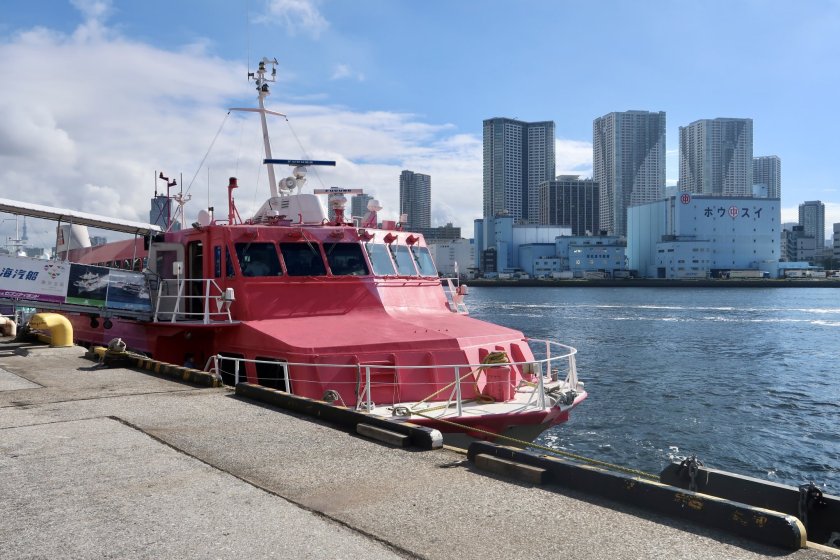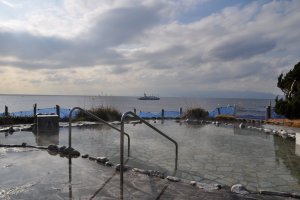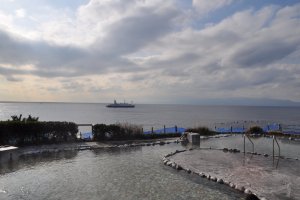A simple ferry ride from Takeshiba Pier in Tokyo’s downtown core (near Hamamatsucho Station)—and still, stunningly, within its prefecture—Oshima island first saw human settlers some 8,000 years ago.
Mt. Mihara, an active stratovolcano seated at the island’s center, erupted many times in recorded history, earning it the moniker “Gojinka,” “fire of the gods” in Japanese. Having served both as a penal colony and as a host to exiles and mystics alike, the island hums with history waiting to be discovered. A swift perusing of its landscapes alone attests to the depth and breadth of its wonders in flora and fauna. This article reflects a two-day journey I partook in on the island to sample its bounty. The below paragraphs are peppered with the musings of Oshima’s residents, detailing the island’s charms and what keeps them there.
[ Day 1 ]
ATV Tour at Ura-sabaku (“Back Desert”)

Ms. Awamoto operates an ATV experience, as well as a “Book Tea Bed,” with her husband. Growing up on Oshima, she moved to Tokyo for college, only to return some twenty years later. “My husband’s mother was a baker (on the island), and that was my dream. So, I chose to apprentice under her. I never did, however, but this island offers safety found in few other locations; everyone is an acquaintance, and we look out for each other.” Their ATV experience starts about thirty minutes south of the dunes themselves and, thus, requires a driver’s license. First, riders cross a bridge and tunnel on the island’s outer roadway while basking in splendid seaside scenery.

Pulling off the road and onto the sand dunes feels similar to driving onto a Martian landscape—if Mars were black instead of reddish. Since the island largely consists of magma, the sand of the dunes display varied shades of black and dark ashen grays. Lending even more surrealism to the striking setting, are the seaside grasses that pierce the sand and reach for the skies as proof of nature’s fierceness.
Riding ATV’s in this scene leaves you breathless. The act of riding one in a foreign country is a rare experience in itself, offering opportunities for the rider to smell the salty air of a Japanese ocean while viewing island wilderness at breakneck speeds. Then, upon arriving at—and riding on—the dunes themselves, the peak experience of coasting through a different universe compares to the stuff of dreams and is single-handedly worth the ferry fare.

Motomachi Hamano-yu

Rattling one’s skeleton around while gripping handlebars on a motorbike—while quite exhilarating—can lead to fatigue and more sore muscles than expected. A common Japanese cure for all of the above, of course, is the onsen, or “hot springs.” Motomachi Hamano-yu, towards the island’s western tip, awaits the weary traveler, offering a space for healing and reflection. Perched right above a beach, with a view of passing ships, its entry fee of 300 yen feels more like a donation. In such a local open-air hot spring (or “rotemburo,” in Japanese) one feels quite immersed in the lifestyle of the islanders, and the cut-stone floors of the tubs ground you in island life. Mr. Yanase, a person in charge of this and the adjoining hot spring, says he has always lived on the island, although, like Ms. Awamoto, he spent some years away from here before returning to his birthplace. He says, “Ashitaba stands out as a speciality of the island’s cuisine, as does our spin on sushi. But, in terms of this onsen, we pride ourselves on creating experiences that will leave guests’ bodies feeling warm long after they have left,” perhaps as an analogy for a visit to the island as a whole.

Cycling at Sunset on the Palm Line Course

While I thoroughly enjoyed being swept away to a strange new world with the ATV experience, this bicycle excursion proved to be my favorite chapter of the two-day journey. Just as motorbikes offer you a bond with life that cars cannot, bicycles take it one step further by slowing things down and making them hyperreal. And, since most everyone rode a bike in their youth, in the land where they were raised, transposing that nostalgic feeling to a foreign land further enhances the experience. As we raced around the seaside course—clearly paved out in red paint—and the sea breeze gently swept across our faces, my heart inflated with a childlike joy.

Palm trees and unknown joyous birds danced before my eyes. This trip was given an extra lift by the bicycles being electric, and it was my first time riding one of that nature. The extra jolt received with each crank of the pedals sends adrenaline coursing through your veins like electricity. And, the sun setting on lava rock extending out into the sea solidified this anecdote.

Farm Stand Buratto House

About half an hour before sunset, we crossed the road from the seaside to drop into Farm Stand Buratto House. Essentially a farmers’ market laid out as a produce shop with an eatery, this business serves exclusively locally-sourced products; from daikon and the island’s sea salt to gnomes sewn from different fabrics. After purchasing a packet of popping corn (made, of course, from corn grown locally), I then consumed an old-school soft serve filled with vanilla ice cream made from milk of local cows. Despite not being a large island, Oshima holds a domestic reputation for its dairy products.


Another must-see at this location, especially at the insta-worthy sunset time, is Buddy’s Bell near Buratto House; a monument symbolizing trust between diving partners. We were told that it’s common to pray or wish for safety here before a dive.

Sushikou

For dinner, being on an island, we indulged in some of the freshest seafood one may hope to savor at Sushikou. My companions and I all ordered the Shima Nigiri (or “local fish sushi” platter) and rejoiced in every scrumptious bite. This assorted dish included local fish nigiri, which is raw fish over vinegared rice, and bekko, a unique island variation of sushi in which the fish is marinated in a chili soy sauce before being placed over rice. I had perhaps never tasted fish this fresh. However, the “Ashitaba Tempura” surprised me even more. A perennial plant grown and promoted as a local specialty, ashitaba quickly won me over as a fan. Its taste spread on my tongue like a breath of fresh air with a reassurance of nutrition densely packed into its leaves. In short, it was like a superfood with a shot of energy and hardly any of the leafy tinge one would expect. Sushikou offers far beyond fish, such as pizza and pasta, however, I was quite delighted to consume the sushi; as it was most local and authentic to the region. On the subject, the young staff recommended that we use soy sauce with island chili peppers with paler fish, as it is a delicacy native to the region and available in most of its gift shops.
[Day 2]
Trekking at Mt. Mihara

Mt. Mihara, I imagine, is the main reason most people board the ferry from Tokyo in the first place. The Japanese government certified this area as a “Geopark” and Mt. Mihara itself as a “stratovolcano,” which is a volcanic landform characterized by a cone shape created by layers of volcanic material deposited over a number of eruptions. The “strata,” or “layers,” can be viewed quite vividly while peering down into its crater and by driving out along the island’s perimeter.

These faulted strata, called Baumkuchen due to their resemblance to the German cake of the same name, are an incredibly rare sight. In fact, there are only a few locations in the world where visitors can witness these natural artworks to this scale. The striped formations are a result of the layering of volcanic ash and black pumice over thousands of years and are situated along Route 208 on the southwestern side of the island.
The trek starts at a parking lot with a splendid view of the island (and Mt. Fuji on a clear day), as well as a police box, an information station for tourists, and public toilets; last stop for about two hours!

The first stretch, or two-thirds, of the way up to the top is paved much like a bicycle path in immaculate black asphalt, making it an ideal place to stroll as a family with members of all ages and all levels of abilities. Stretching out on all sides, the scenery is like an alien world.

Adding to the surreal nature of the climb, there are half-tube shelters along the slope. These structures are meant to provide a measure of safety in case of a volcanic eruption which would be announced by loud speakers around the park. The last eruption was in 1986, however, so rest assured that dangerous occurrences are rare.

About two-thirds of the way up Mt. Mihara, the path shifts from paved to a natural floor of earth and stones. And, ironically, this change made it easier to proceed without getting tired.
While the pavement enhanced “accessibility” for the first half of the “hike,” at some point before the half-way mark, the paved steep inclines became more challenging. Closer to the apex, two elements of nature hit my mind quite intensely; one for its presence, and the other for its absence. First of all, since Tokyo has little snow and we correlate volcanoes with heat, I was quite surprised to find some snow icing the volcano’s summit, despite steam seeping out from cracks in nearby hills. The second element that struck me was the absence of the smell of sulfur, since hot springs are often haunted by this scent.

The crater then seemed to leap into sight out of thin air after about an hour into our trek. Kept at a safe distance between tourists and a fence, it brandished otherworldly hues of reds, yellows, and blacks; like an alien rainbow, an omen, or a warning. After taking in this stunning feat of nature, the walk back down the mountain felt much shorter than the ascent, partially for its unpaved nature yielding more to human feet.
Habu Port

To wrap up our two-day voyage, we decided to go deeper on a local level and visited Habu Port, or “Habu Minato,” in local parlance. On the southeast tip of the island, this quaint hamlet, which must have been a fishing village in days of yore, now plays host to two famous eateries. One, at ground zero, nestled in a backstreet, was run by a quiet elderly woman who told us she did not want any more fame. Visits by celebrities had inspired some young people to travel to Oshima for her croquettes, and the proprietress begged me not to mention the name of her shop in my article. Nevertheless, it’s easy to find, as the village is quite small.
A nearby winding cement staircase swept us up past an old shrine and landed us in front of yet another haunt of the famous.

Crafted out of a 120-year-old house, Tokyo Voneten serves an impressive flow of customers with its taiyaki; fish-shaped Japanese confections, usually stuffed with sweet red bean paste. Ms. Kawamura, who owns and runs the shop with her husband, recounts that her eatery was visited by a celebrity hosting a TV program and that, afterwards, the shop went viral on social media.

The atmosphere feels deeply inviting, with dark wood framing outlining the whole, seating and tables of matching ambiance, and a floor of volcanic pebbles making the decor so grounding you almost want to curl up for a nap.
The eatery sells traditional red bean taiyaki (which boast a large helping of extraneous dough), as well as unique varieties, including cold taiyaki made with ashitaba-flavored dough, apple custard, Oshima passion cream, and seasonal flavors.
The shop also offers various other local specialities and retails locally-designed t-shirts, power-stone bracelets, and salt from the local sea for spiritual cleansing. Oddly enough, none of it seemed out of place, and, by contrast, seemed to play well into the shop’s funky air.

Ms. Kawamura says she moved here partially because she thought it was a special place, due to its nature being so well preserved. She says that she feels that people flock to her shop for the generous size of their servings and for rare offerings like the ashitaba taiyaki. A small poster beside the cash register shows that they accept a variety of payments. Having loved my first taste of ashitaba at the sushi bar as tempura the night before, I bit into a strawberry-custard-filled ashitaba taiyaki. The essence of the leaf lent the pastry a greenish tinge—granting it an authentic fishy look—and its combination with the strawberry custard generated one of the most yummy things I’ve ever eaten.

However, despite all of Oshima’s charms, the most common reason for its inbound tourism, and its claim to fame, is its “tsubaki” flowers, or Japanese camellia in English. From late January to late March, Oshima celebrates this regional symbol and dedicates festivities to its beauty. Troupes of islanders also perform festival-related entertainment connected to the festival all around the island. And, a short drive southeast of Habu Port, the Yamaguchi Tsubaki Tunnel grants a storybook-like chance to drive through a passage shaped from Japanese camellia trees.

From hiking a volcano to racing through surreal black sand dunes on an ATV, and from cycling along an exotic coastline to tasting island specialties, Oshima is more than a place that offers something for everyone. It is a destination where all visitors are beckoned to partake in every known pleasure. Like its emblematic flower—the most festive tsubaki—Oshima invites you to visit and blossom to your fullest.

Access to Oshima
As Oshima is the closest Izu Island to central Tokyo, it is easily accessible via ferry and plane.
Ferry
From Takeshiba Pier, you can reach Oshima with a high-speed jet ferry (one hour and 45 minutes) or a large passenger ship (eight hours). You can review the ferries’ service periods here and make reservations online or via phone.
Plane
From Chofu Airport in western Tokyo, New Central Airservice operates three flights daily to Oshima Airport. The flight time is about 25 minutes. You can make reservations online or via phone.
Promoted and funded by:



































